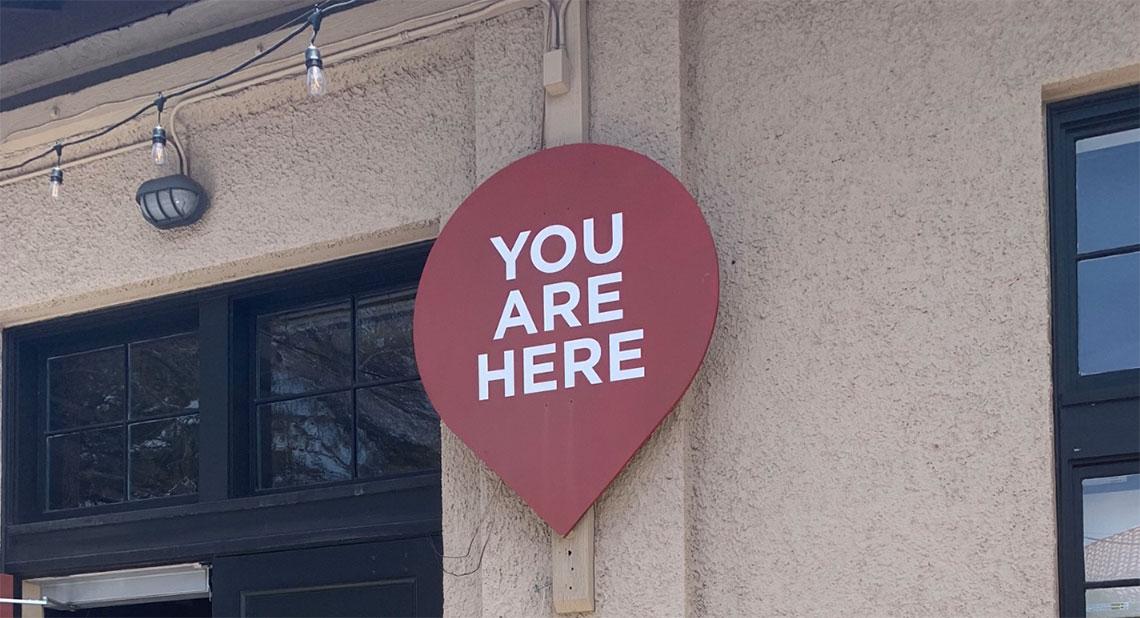
You are here: a reflection of my experience at Stanford’s Designing Your Life studio
By: Hannah Scully
DesignThis is a special guest blog contribution from Hannah Scully. Hannah is an undergraduate Barrett Honors College student in the Mary Lou Fulton College for Teaching and Learning Innovation and completed her Honors Thesis on design thinking and its use throughout education. She is an Education Mentor, Secretary of the Teachers College Council, and a member of the Page Turners Club.
You are here. This was the message plastered all over the Stanford d.school building and the Life Design Studio in sunny Palo Alto, California. You can’t go far without the gentle reminder. Usually, this phrase refers to a physical location: where you’re located, and that’s it. But in Life Design, “you are here” holds so much more. Before you can begin to design your life or approach change in your life, you have to stop and take stock of what your life is at this moment in time. Forget where you want to be for a moment, the things you want to do, or the workout class you are for sure going to attend this time. You have to be honest with yourself. Where do you live now? What are your responsibilities at this moment? What are you struggling to do and accomplish? In Life Design, you have to start from where you are and accepting the person you are at this point in time is key to beginning to understand where you want to go. That is the first key step to monumental growth and self-understanding.

Lessons like these were packed into an inspirational four days of participating in and learning about Designing Your Life curriculum, presented by leaders of the Life Design Lab at Stanford. I was lucky enough to attend as a part of the Arizona State team with Christina Ngo and Hannah Jennewin and meet other incredible university leaders from all around the world. We all came together to learn about design thinking and Life Design, as well as to find potential applications within the universities we represented.
Life design is defined as applying the principles of design thinking (accept, empathize, define, ideate, prototype, test) to the wicked problem that is designing your life: what you want to be, what you want to do, and what you want to grow into. Many universities were looking to utilize life design in career development roles for students, introductory freshman courses, and even creating classes targeting other specific populations like veterans. Seeing the different potential applications of the same process was mindblowing in itself for me, and it was incredible to see so many universities focused on improving the college experience for students.
Stepping into this four-day experience, there was a lot I expected. I expected to be challenged, to learn lessons I never saw coming. I expected the chance to hear valuable perspectives from a variety of people. I expected to leave with a toolbox to help myself grow and to help guide others while they grow. What I never expected was to consistently see and hear the same lesson my professors at the Mary Lou Fulton College for Teaching and Learning Innovation emphasize in almost every class session: in order to improve, you have to reflect.
Throughout the studio experience, I was reminded that true reflection requires deliberate and thoughtful action. For life designers to be able to create any change, you have to first start with where you are. Like I mentioned before, determining where you are depends wholly on being honest with yourself and collecting evidence to support your ideas. Reflection can be painful and uncomfortable, especially when the conclusions challenge the status quo or your own personal comfort zone. Through activities like writing out my own worldview and workview, creating five-year plans (Odyssey Plans), and networking games, I realized that beyond wanting to teach, I wasn’t sure what I wanted next. Where do I want to go? And, that was scary.
I’ve wanted to teach since before I can remember. The pursuit of a teaching degree is so ingrained into my life at this point, I wouldn’t know what to do without it. But in the Design Lab, I was forced to explore that world and to reflect on where I am to then think about where I wanted to go. In five years, what do I expect my life to look like and what do I want it to look like? I had to reflect and deeply reflect. But by being vulnerable with myself and others in the room, I was able to find steps forward and come away with a greater understanding of myself and my potential path forward through life. For me, perhaps the most valuable takeaway from the whole experience was one that, in different contexts, I had already been taught. To understand how to move forward, you sometimes have to look back. You have to reflect.